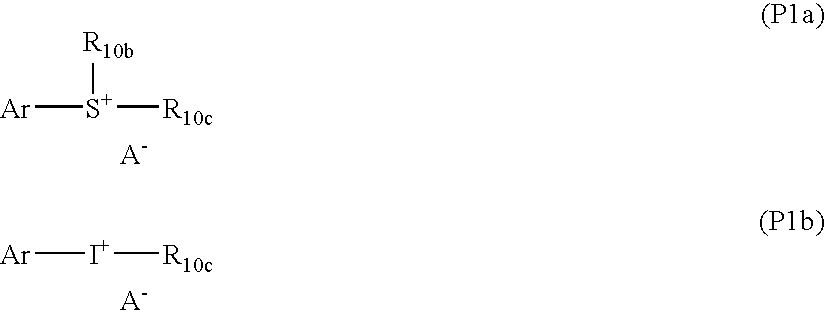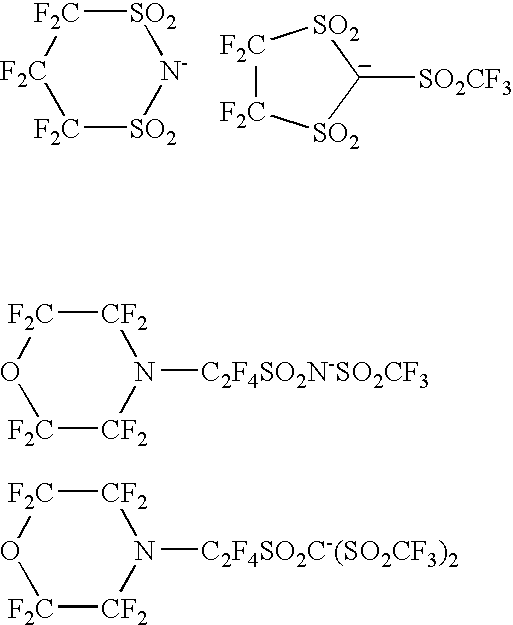Coating composition
- Summary
- Abstract
- Description
- Claims
- Application Information
AI Technical Summary
Benefits of technology
Problems solved by technology
Method used
Image
Examples
example 1
Preparation of bis(4-hydroxyphenyl)phenylsulfonium nonaflate (BHPPSNF)
[0128]Bis(4-hydroxyphenyl)phenylsulfonium triflate (2.5 g, 0.00739 moles; Dainippon Pharmaceuticals) was dissolved in 20 mL of water in a suitable container to which was added potassium nonaflate (3.28 g, 0.00739 mole). To this mixture was added 120 mL of water, which formed a cloudy solution. This solution was stirred overnight at room temperature in a stoppered flask. The formed oil was separated from the aqueous layer by decanting this layer away. The residual oil was washed with 2 mL of distilled water. This residue was dissolved in 4 mL acetone and another 2.6 g of potassium nonaflate and 100 mL of water. This mixture was then extracted with 100 mL of methylene chloride after stirring overnight. The methylene chloride layer was washed with water several times and stripped of solvents. Dissolving in a minimum of methylene chloride the residue was precipitated with pentane and then dried under high vacuum to gi...
example 2
Preparation of bis(bis(4-hydroxyphenyl)phenylsulfonium) 1,4-perfluorobutanedisulfonate (BHPPSFBDS)
[0129]Bis(4-hydroxyphenyl)phenylsulfonium triflate (2.5 g, 0.00570 mole) was dissolved in 25 mL of acetone in a suitable container to which was added while stirring a solution consisting of di-potassium 1,4-perfluorobutanedisulfonate (4.07 g, 0.0114 mole; 3M). A clear solution was obtained upon stirring. To this solution was added 100 mL of methylene chloride. After overnight stirring, crystals formed in the solution. The crystals were filtered and washed subsequently with distilled water and methylene chloride. The crystals obtained were then exchanged a second time with another aliquot of dipotassium 1,4-perfluorobutanesulfonate as described above. This resulted in 2.17 g of white solid (40% yield) which was pure material free of triflate as seen by 19F NMR and otherwise pure of other impurities as seen by 1H NMR.
example 3
Preparation of bis(4-vinyloxyethyloxyphenyl)phenylsulfonium triflate (BVOPSTF)
[0130]A 3-neck-round bottom flask was fitted with a condenser, an addition funnel, nitrogen source, and a magnetic bar. Sodium hydroxide (8.64 g, 0.216 mol), bis(4-hydroxyphenyl)phenylsulfonium triflate (16 g, 0.036 mol) and DMSO (90 ml) were added to a round bottom flask under N2. The mixture was heated to 60° C. for 1 hour. 2-chloroethyl vinylether (23 g, 0.216 mol) was added dropwise to the mixture via the addition funnel. The temperature was then increased to 80° C. and the reaction was held at that temperature for 5 hours. The reaction mixture was then allowed to cool down to room temperature. Thereafter, the reaction mixture was poured into diethyl ether to form three layers: aqueous, ether, and an oil. DI water was used to wash the ether solution 3 times. An oily layer was collected and concentrated to dryness. 12.9 g (61.5%) of bis(4-vinyloxyethyloxyphenyl)phenylsulfonium triflate was obtained. The...
PUM
| Property | Measurement | Unit |
|---|---|---|
| acid labile | aaaaa | aaaaa |
| antireflective | aaaaa | aaaaa |
| composition | aaaaa | aaaaa |
Abstract
Description
Claims
Application Information
 Login to View More
Login to View More - R&D
- Intellectual Property
- Life Sciences
- Materials
- Tech Scout
- Unparalleled Data Quality
- Higher Quality Content
- 60% Fewer Hallucinations
Browse by: Latest US Patents, China's latest patents, Technical Efficacy Thesaurus, Application Domain, Technology Topic, Popular Technical Reports.
© 2025 PatSnap. All rights reserved.Legal|Privacy policy|Modern Slavery Act Transparency Statement|Sitemap|About US| Contact US: help@patsnap.com



